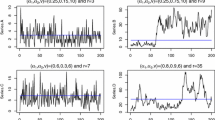Abstract
Integer-valued time series models and their applications have attracted a lot of attention over the last years. In this paper, we introduce a class of observation-driven random coefficient integer-valued autoregressive processes based on negative binomial thinning, where the autoregressive parameter depends on the observed values of the previous moment. Basic probability and statistics properties of the process are established. The unknown parameters are estimated by the conditional least squares and empirical likelihood methods. Specially, we consider three aspects of the empirical likelihood method: maximum empirical likelihood estimate, confidence region and EL test. The performance of the two estimation methods is compared through simulation studies. Finally, an application to a real data example is provided.
Similar content being viewed by others
References
Al-Osh, M. A., & Alzaid, A. A. (1987). First-order integer-valued autoregressive (INAR(1)) process. Journal of Time Series Analysis, 8, 261–275.
Brillinger, D. R. (2001). Time series: data analysis and theory. Society for Industrial and Applied Mathematics.
Ding, X., & Wang, D. (2016). Empirical likelihood inference for INAR(1) model with explanatory variables. Journal of the Korean Statistical Society, 45, 623–632.
Gomes, D., & Cantoe Castro, L. (2009). Generalized integer-valued random coefficient for a first order structure autoregressive (RCINAR) process. Journal of Statistical Planning and Inference, 139, 4088–4097.
Hall, P., & Heyde, C. C. (1980). Martingale limit theory and its application. New York: Academic Press.
Joe, H. (1996). Time series models with univariate margins in the convolution-closed infinitely divisible class. Journal of Applied Probability, 33, 664–677.
Kitamura, Y. (1997). Empirical likelihood methods with weakly dependent processes. The Annals Statistics, 5, 2084–2102.
Klimko, L. A., & Nelson, P. I. (1978). On conditional least squares estimation for stochastic processes. The Annals of Statistics, 6, 629–642.
Leonenko, N. N., Savani, V., & Zhigljavsky, A. A. (2007). Autoregressive negative binomial processes. Annales de l’I.S.U.P, 51, 25–47.
Li, H., Yang, K., Zhao, S., & Wang, D. (2017). First-order random coefficients integer-valued threshold autoregressive processes. Asta Advances in Statistics Analysis, 1, 1–27.
Monteiro, M., Scotto, M. G., & Pereira, I. (2012). Integer-valued self-exciting threshold autoregressive processes. Communications in Statistics. Theory and Methods, 41, 2717–2737.
Mykland, P. A. (1995). Dual likelihood. The Annals of Statistics, 23, 396–421.
Owen, A. B. (1988). Empirical likelihood ratio confidence intervals for a single functional. Biometrika, 75, 237–249.
Qin, J., & Lawless, J. (1994). Empirical likelihood and general estimating equations. The Annals of Statistics, 22, 300–325.
Ristić, M. M., Bakouch, H. S., & Nastić, A. S. (2009). A new geometric first-order integer-valued autoregressive (NGINAR(1)) process. Journal of Statistical Planning and Inference, 139, 2218–2226.
Ristić, M. M., Nastić, A. S., & Bakouch, H. S. (2012). Estimation in an integer-Valued autoregressive process with negative binomial marginals (NBINAR(1)). Communications in Statistics. Theory and Methods, 41, 606–618.
Scotto, M. G., Weiß, C. H., & Gouveia, S. (2015). Thinning-based models in the analysis of integer-valued time series: a review. Statistical Modelling, 15, 590–618.
Steutel, F., & van Harn, K. (1979). Discrete analogues of self-decomposability and stability. The Annals of Probability, 7, 893–899.
Triebsch, L. K. (2008). New integer-valued autoregressive and regression models with state-dependent parameters (Doctoral dissertation), Munich: TU Kaiserslautern, Verlag Dr. Hut.
Tweedie, R. L. (1975). Sufficient conditions for ergodicity and recurrence of Markov chains on a general state space. Stochastic Processes and their Applications, 3, 385–403.
Weiß, C. H. (2008). Thinning operations for modeling time series of counts: a survey. ASTA Advances in Statistical Analysis, 92, 319–343.
Weiß, C. H., & Kim, H. Y. (2014). Diagnosing and modelling extra-binomial variation for time-dependent counts. Applied Stochastic Models in Business and Industry, 30, 588–608.
Weiß, C. H., & Pollett, P. K. (2014). Binomial autoregressive processes with density dependent thinning. Journal of Time Series Analysis, 35, 115–132.
Wu, R., & Cao, J. (2011). Blockwise empirical likelihood for time series of counts. Journal of Multivariate Analysis, 102, 661–673.
Zhang, H., Wang, D., & Zhu, F. (2011a). Empirical likelihood for first-order random coefficient integer-valued autoregressive processes. Communications in Statistics. Theory and Methods, 40, 492–509.
Zhang, H., Wang, D., & Zhu, F. (2011b). Empirical likelihood inference for random coefficient INAR(p) process. Journal of Time Series Analysis, 32, 195–223.
Zhang, H., Wang, D., & Zhu, F. (2012). Generalized RCINAR(1) process with signed thinning operator. Communications in Statistics. Theory and Methods, 41, 1750–1770.
Zheng, H., Basawa, I. V., & Datta, S. (2006). Inference for pth order random coefficient integer-valued autoregressive processes. Journal of Time Series Analysis, 27, 411–440.
Zheng, H., Basawa, I. V., & Datta, S. (2007). First order random coefficient integer-valued autoregressive processes. Journal of Statistical Planning & Inference, 137, 212–229.
Zheng, H., Basawa, I. V., & Datta, S. (2008). First-order observation-driven integer-valued autoregressive processes. Statistics & Probability Letters, 78, 1–9.
Zhu, F., & Wang, D. (2015). Empirical likelihood for linear and log-linear INGARCH models. Journal of the Korean Statistical Society, 44, 150–160.
Author information
Authors and Affiliations
Corresponding author
Rights and permissions
About this article
Cite this article
Yu, M., Wang, D. & Yang, K. A class of observation-driven random coefficient INAR(1) processes based on negative binomial thinning. J. Korean Stat. Soc. 48, 248–264 (2019). https://doi.org/10.1016/j.jkss.2018.11.004
Received:
Accepted:
Published:
Issue Date:
DOI: https://doi.org/10.1016/j.jkss.2018.11.004




